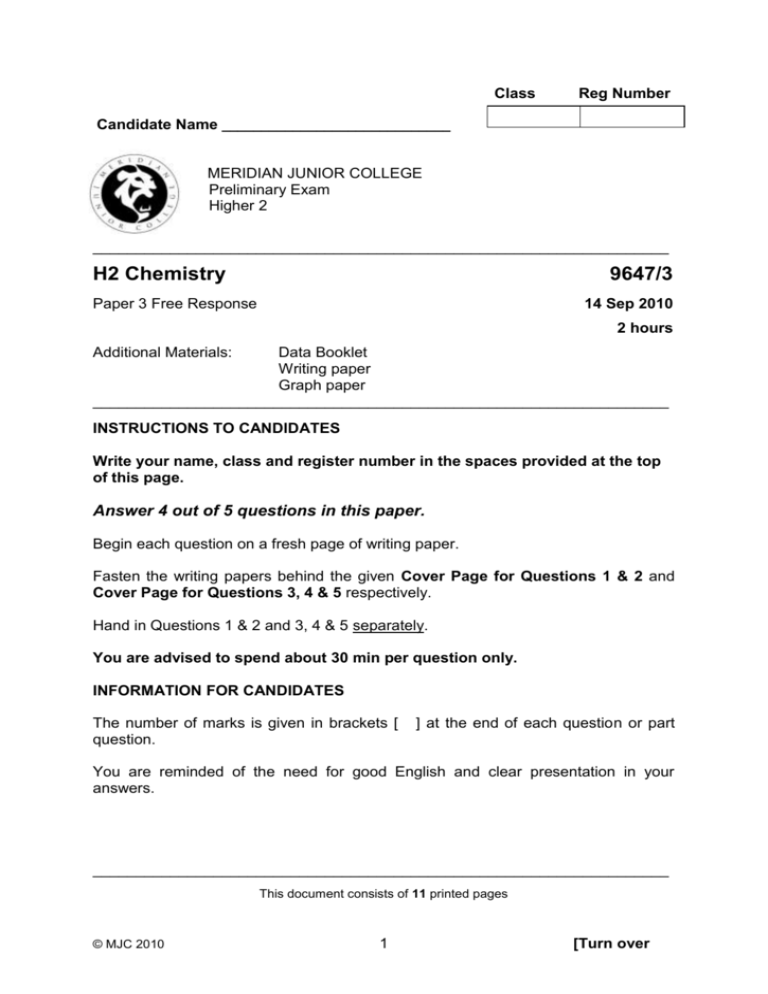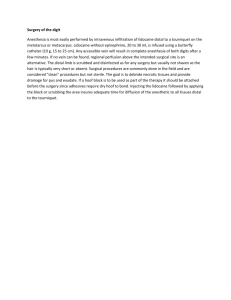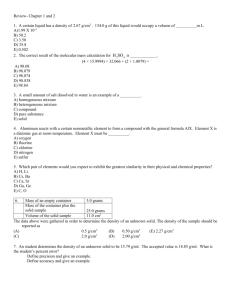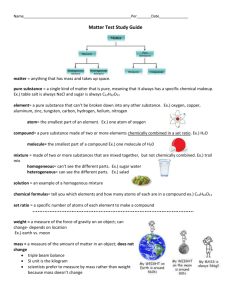2010-MJC-CH-H2-P3-Prelim
advertisement

Class Reg Number Candidate Name _____________________________ MERIDIAN JUNIOR COLLEGE Preliminary Exam Higher 2 ___________________________________________________________________ H2 Chemistry 9647/3 Paper 3 Free Response 14 Sep 2010 2 hours Additional Materials: Data Booklet Writing paper Graph paper ___________________________________________________________________ INSTRUCTIONS TO CANDIDATES Write your name, class and register number in the spaces provided at the top of this page. Answer 4 out of 5 questions in this paper. Begin each question on a fresh page of writing paper. Fasten the writing papers behind the given Cover Page for Questions 1 & 2 and Cover Page for Questions 3, 4 & 5 respectively. Hand in Questions 1 & 2 and 3, 4 & 5 separately. You are advised to spend about 30 min per question only. INFORMATION FOR CANDIDATES The number of marks is given in brackets [ question. ] at the end of each question or part You are reminded of the need for good English and clear presentation in your answers. ___________________________________________________________________ This document consists of 11 printed pages © MJC 2010 1 [Turn over 1 (a) (b) Lidocaine and Procaine are common local anaesthetics used in dental surgeries and minor operations. Lidocaine Procaine pKb = 6.1 pKb = 5.1 (i) There are two functional groups involving the N atom in Lidocaine. Explain which of these functional groups is less basic. (ii) Using the letter ‘B’ to represent the base, write an expression for the base dissociation constant of Lidocaine. Calculate the pH of a 0.025 mol dm-3 solution of Lidocaine. (iii) Hydrochloric acid is added to 1 dm3 of the Lidocaine solution in a(ii) to produce a buffer solution. Determine the volume of 0.500 mol dm-3 HCl required to form a buffer solution of pH 7. (iv) With the aid of an equation, explain how the buffer solution in (a)(iii) can control pH when a small amount of base is added. [9] The pKb values of the two bases show that Procaine is a stronger base than Lidocaine. (i) A sample of Procaine was found to have higher electrical conductivity than a sample of Lidocaine of equal concentration. Explain this observation with reference to the pKb values. (ii) Suggest a simple chemical test to distinguish Lidocaine and Procaine. (iii) Draw the structural formulae of the organic products formed when hot acidified potassium manganate(VII) is added to Lidocaine. [5] © MJC 2010 2 [Turn over (c) Lidocaine can be synthesised using 1,3-dimethylbenzene as the starting reagent. Propose a 4 step synthesis route for the formation of Lidocaine, showing clearly the reagents, conditions and structures of intermediates formed. (d) Lidocaine is converted to compound Q according to the following steps. (i) Identify the type of reactions for Reaction I and III. (ii) Reaction II is conducted using a controlled amount of bromoethane and the yield of compound P is low. Suggest how the sequence in the synthesis can be improved to raise the yield of compound P. [6] [Total: 20] © MJC 2010 3 [Turn over 2 (a) A cell set up between Ni2+(aq) / Ni(s) half cell and an unknown metal electrode X2+(aq) / X(s) half cell has the following cell notation: X (s) / X 2+(aq) // Ni2+ (aq) / Ni (s) The standard cell potential was found to be + 0.51 V. (b) (i) Use the Data Booklet to calculate the standard electrode potential of the X 2+(aq) / X(s) half cell and hence identify X. (ii) Draw a fully labelled diagram of how you would determine the standard electrode potential of the Ni2+(aq) / Ni(s) system. (iii) Explain the effect, if any, on the e.m.f. of the cell on adding aqueous NaOH to the Ni 2+(aq) / Ni (s) half cell. [6] A student attempted to coat a heart-shaped pendant with nickel in the laboratory. A total of 15.0 g of nickel metal was used to plate the pendant using nickel nitrate, Ni(NO3)2 as the electrolyte. Calculate the total time taken, in hours, for the electroplating process if a current of 12 A was used for the process. [2] (c) Direct-ethanol fuel cells also known as DEFCs are fuel cells where the fuel, ethanol, is fed directly to the fuel cell, with a polymer acting as the electrolyte. A diagram of a DEFC is shown below. Direct Ethanol Fuel Cell (DEFC) CO2 out Water out Ethanol in Air in Anode © MJC 2010 Electrolyte 4 Cathode [Turn over (i) Write the half-equations for the reactions which take place at the electrodes of the fuel cell, and hence an overall equation with state symbols for the cell reaction. (ii) A more common fuel cell currently used in industries is the Direct-methanol fuel cells or DMFCs. However, more research is done in the use of ethanol as fuel as it is more energy efficient than methanol. Give a reason for the differing energy efficiency of the alcohols. (iii) Two alcohols that could be used to drive the alcohol fuel cells were reacted with alkaline KMnO4 to form two different mono-carboxylate salts, RCO2- and R’CO2-. When a mixture of mono-carboxylate salts was electrolysed, a mixture of alkanes was produced. RCO2- + R’CO2- R—R + R—R’ + R’—R’ Electrolysing a mixture of the salts of the two mono-carboxylic acids S and T produced three alkanes U, V and W. (1) Given that alkane U has a Mr of 30.0, draw the structural formula of U. (2) A gaseous sample of 0.25 g of V occupied a volume of 142 cm3 at a temperature of 127 oC and a pressure of 1 atm. Use these data to calculate the Mr of V and suggest its molecular formula. (3) A 20 cm3 sample of W was burnt in 250 cm3 of excess oxygen. The remaining gases occupied a volume of 180 cm3 but this volume was reduced to 60 cm3 after passing the gases through aqueous sodium hydroxide. Given that W is a branched and symmetrical alkane, deduce the full structural formula of W. (4) Based on your answers in (1) – (3), deduce the structures of carboxylic acids S and T. [12] [Total: 20] © MJC 2010 5 [Turn over 3 Ammonia is manufactured industrially through the Haber process. Nitrogen gas is an important reagent in this process. (a) Nitrogen gas is produced from the decomposition of dinitrogen oxide, N2O in the presence of a gold surface at 1200K. 2 N2O (g) 2 N2 (g) + O2 (g) The rate of decomposition of pure N2O is investigated by measuring the partial pressure of N2 produced. The following results are obtained. Time, t / min 0 5 Partial pressure of N2, PN2 / Pa 0 6.8 10 15 20 25 30 12.4 17.2 20.8 24.0 26.5 35 29 40 45 30.5 32.0 After a sufficiently long time, the partial pressure of N2 stabilises at 40.0 Pa. (b) (i) Using a graphical method, deduce the order of reaction with respect to N2O. (ii) Write an expression for the rate equation and calculate the rate constant. [5] Nitrogen gas can also be produced when nitrogen monoxide reacts with hydrogen gas in the following equation. 2NO(g) + 2H2(g) N2(g) + 2H2O(g) The following mechanism has been proposed for the reaction: Step I: NO + NO N2O2 Step II: N2O2 + H2 H2O + N2O (slow) Step III: N2O + H2 N2 + H2O Suggest the rate equation for the above reaction. © MJC 2010 6 [1] [Turn over (c) (d) Nitrogen and hydrogen are reacted to produce ammonia gas via the Haber process using iron as a catalyst. (i) Explain why iron can act as a heterogeneous catalyst. (ii) With the aid of the Maxwell-Boltzman distribution curve, describe how the presence of iron catalyst increases the rate of reaction of Haber process. [4] Transition elements such as iron usually form stable coloured ions in aqueous solutions. (i) Explain why aqueous Fe3+ solutions are coloured while Sc3+ solutions are colourless. (ii) When iodide ions are added to an iron(III) sulfate solution of pH 1, a brown solution is obtained. However, when the same process is repeated in an iron(III) sulfate solution of pH 10, no brown solution is observed. Identify the brown solution and use the E values from the Data Booklet to explain the difference in the observations of the two experiments. [7] (e) When aqueous ammonia is gradually added to a solution containing copper(II) ions, a pale blue precipitate is formed, which then dissolves on the addition of excess aqueous ammonia. Explain the above observations and write equations for the reactions that occur. [3] [Total: 20] © MJC 2010 7 [Turn over 4 Strontium hydroxide is a strong base and has several industrial applications such as plastic stabiliser and paint drier. (a) The standard enthalpy change of neutralisation was determined experimentally by mixing known volumes of aqueous hydrochloric acid and aqueous strontium hydroxide. The process was known to be only 80% efficient. The following results were obtained. (b) Initial temperature = 25.0 C Final temperature = 33.5 C Volume of 2 mol dm–3 HCl (aq) used = 50 cm3 Volume of 0.77 mol dm–3 Sr(OH)2 (aq) used = 50 cm3 (i) Define standard enthalpy change of neutralisation. (ii) Use the above data to calculate the standard enthalpy change of neutralisation in kJ mol-1. [Assume that the heat capacity of all solutions = 4.2 J K-1 cm-3.] (iii) The enthalpy change of neutralisation between aqueous strontium hydroxide and aqueous ethanoic acid is found to be less exothermic than the value calculated in (a)(ii). Explain why this is so. [5] Aqueous strontium hydroxide is formed when solid strontium metal reacts with water. Hrxn Sr (s) + 2H2O(l) Sr2+(aq) + 2OH-(aq) + H2 (g) By using the following enthalpy changes, your answer in (a)(ii) and relevant data in the Data Booklet, draw an energy level diagram to calculate the enthalpy change for the above reaction involving strontium and water. kJ mol-1 Enthalpy change of atomisation of strontium +164 Enthalpy change of hydration of strontium ions −1337 Enthalpy change for 2H+(aq) + 2e H2(g) −850 [4] © MJC 2010 8 [Turn over (c) Other strontium compounds such as SrF2 and SrSO4 are sparingly soluble in water. Their solubility products at 298 K are given in the table below: Strontium compound Numerical value of Ksp SrF2 2.5 x 10-9 SrSO4 3.2 x 10-7 (i) Suggest using quantitative calculations, which of the two compounds is more soluble in water at 298K. (ii) A sample of SrF2 is dissolved in a solution of NaF. Predict qualitatively the effect (if any) on the solubility and solubility product of SrF2. (iii) A student accidentally mixed 50.0 cm3 of 0.100 mol dm–3 BaCl2 solution with 50.0 cm3 of 0.100 mol dm–3 SrCl2 solution in the laboratory. To separate the two metal ions, he added just enough solid KF to precipitate the maximum amount of SrF2 from the mixture, without precipitating BaF2. (1) (2) Given that the Ksp of BaF2 is 1.70 x 10-6 mol3 dm-9, determine the concentration of Ba2+ and F- solution that can be used for this separation. Calculate the concentration of Sr2+ in the final solution. [8] (d) When a precipitate is formed, Gppt, in J mol-1, is given by the following expression. Gppt = RT ln Ksp (i) Use the data in (c) to calculate Gppt, in kJ mol-1, for SrSO4. (ii) The standard enthalpy change of formation of SrSO4(s) is -1453 kJ mol-1. Use your answer in (d)(i) to calculate Sppt, in J mol-1 K-1, for the formation of the precipitate SrSO4(s) at 298 K. (iii) Explain the significance of the sign of your answer in (d)(ii). [3] [Total: 20] © MJC 2010 9 [Turn over 5 Both halogenoalkanes and acyl halides are halogen containing organic compounds. They are used in many industrial and commercial applications. (a) The physical and chemical properties of the following halogenoalkanes and acyl halide are shown below. Compound 2-chlorobutane 2-iodobutane butanoyl chloride 69 119 102 White ppt forms after 15 mins Yellow ppt forms almost immediately White ppt forms immediately Heat in sealed tube Heat in sealed tube r.t.p. Properties Boiling point / ºC Reaction with NaOH (aq), followed by acidified AgNO3 (aq) Conditions required for reaction with NH3 (g) (b) (i) Explain why the boiling point of 2-chlorobutane is lower than that of 2-iodobutane. (ii) Explain the relative rate of formation of precipitate upon reacting 2-chlorobutane and 2-iodobutane with NaOH (aq), followed by acidified AgNO3 (aq). (iii) Suggest a reason for the different conditions required when 2-chlorobutane and butanoyl chloride are reacted separately with gaseous NH3. [6] Compound 1: 1-bromobutane, CH3CH2CH2CH2Br Compound 2: 3-bromo-3-methylhexane, CH3CH2C(Br)(CH3)CH2CH2CH3 Compound 1 reacts with ethanolic sodium cyanide to form F, while compound 2 forms G which is a mixture of isomers. G is found to be optically inactive. (i) Sketch a labelled energy profile diagram for the exothermic reaction of compound 1 with ethanolic sodium cyanide to form compound F. (ii) Outline the mechanism for the formation of G. (iii) Hence, or otherwise, explain why G is optically inactive. [6] © MJC 2010 10 [Turn over (c) Compound H (Mr = 98.0) has a composition by mass of C, 73.5%; H, 10.2%; O, 16.3%. H does not react with PCl5 but reacts with hot acidified K2Cr2O7. H reacts with hot, acidified KMnO4 to form I, C4H8O, and two moles of CO2. I reacts with HCN to form J. When reacted with LiAlH4 in dry ether at r.t.p., J forms K, C5H13NO. H also reacts with HBr to form L and M, both of which are optically active. Deduce the structural formulae of H, I, J, K, L and M, explaining your reasoning. [8] [Total: 20] END OF PAPER © MJC 2010 11 [Turn over






